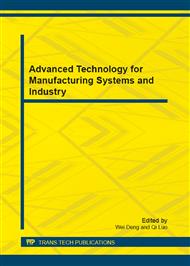[1]
V.S. Chedea, C. Echim, C. Braicu, M. Andjelkovic, R. Verhe, C. Socaciu, Composition in polyphenols and stability of the aqueous grape seed extract from the Romanian variety Merlot Recas,. J. Food Biochem. 35 (2011) 92-108.
DOI: 10.1111/j.1745-4514.2010.00368.x
Google Scholar
[2]
C.P. Passos, R.M. Silva, F.A.D. Silva, M.A. Coimbra, C.M. Silva, Supercritical fluid extraction of grape seed (Vitis vinifera L. ) oil: Effect of the operating conditions upon oil composition and antioxidant capacity. Chem. Eng. J. 160 (2010).
DOI: 10.1016/j.cej.2010.03.087
Google Scholar
[3]
A.V.S. Perumalla, N.S. Hettiarachchy, Green tea and grape seed extracts: Potential applications in food safety and quality. Food Res. Int. 44 (2011) 827-839.
DOI: 10.1016/j.foodres.2011.01.022
Google Scholar
[4]
S.G. Alonso, E.G. Romero, I.H. Gutierrez, HPLC analysis of diverse grape and wine phenolics using direct injection and multidetection by DAD and fluorescence. J. Food Compos. Anal. 20 (2007) 618-626.
DOI: 10.1016/j.jfca.2007.03.002
Google Scholar
[5]
I.I. Rockenbach, L.V. Gonzaga, V.M. Rizelio, S.S. Goncalves, M.I. Genovese, R. Fett, Phenolic compounds and antioxidant activity of seed and skin extracts of red grape (Vitis vinifera and Vitis labrusca) pomace from Brazilian winemaking. Food Res. Int. 44 (2011).
DOI: 10.1016/j.foodres.2011.01.049
Google Scholar
[6]
H. Yang, B. Kuang, A.M. Mouazen, Quantitative analysis of soil nitrogen and carbon at a farm scale using visible and near infrared spectroscopy coupled with wavelength reduction. Eur. J. Soil Sci. 63(2012)410-420.
DOI: 10.1111/j.1365-2389.2012.01443.x
Google Scholar
[7]
L. Velasco, J. Fernandez-Martinez, A.D. Haro, A. De Haro, Application of near infrared spectroscopy to estimate the bulk density of Ethiopian mustard seeds. J. Sci. Food Agric. 77 (1998) 312-318.
DOI: 10.1002/(sici)1097-0010(199807)77:3<312::aid-jsfa39>3.0.co;2-z
Google Scholar
[8]
A. Fassio, D. Cozzolino, Non-destructive prediction of chemical composition in sunflower seeds by near infrared spectroscopy. Ind. Crop. Prod. 20 (2004) 321-329.
DOI: 10.1016/j.indcrop.2003.11.004
Google Scholar
[9]
C.R. Moschner, B. Biskupek-Korell, Estimating the content of free fatty acids in high-oleic sunflower seeds by near-infrared spectroscopy. Eur. J. Lipid Sci. Technol. 108 (2006) 606-613.
DOI: 10.1002/ejlt.200600032
Google Scholar
[10]
A.G. Patil, M.D. Oak, S.P. Taware, S.A. Tamhankar, V.S. Rao, Nondestructive estimation of fatty acid composition in soybean [Glycine max (L. ) Merrill] seeds using Near-infrared Transmittance Spectroscopy. Food Chem. 120 (2010) 1210-1217.
DOI: 10.1016/j.foodchem.2009.11.066
Google Scholar
[11]
M.A. Cantarelli, I.G. Funes, E.J. Marchevsky, J.M. Camiña, Determination of oleic acid in sunflower seeds by infrared spectroscopy and multivariate calibration method. Talanta. 80 (2009) 489-492.
DOI: 10.1016/j.talanta.2009.07.004
Google Scholar
[12]
R. Ferrer-Gallego, M. García-Marino, J.M. Hernández-Hierro, J.C. Rivas-Gonzalo, M.T. Escribano-Bailón, Statistical correlation between flavanolic composition, colour and sensorial parameters in grape seed during ripening. Anal. Chim. Acta. 660 (2010).
DOI: 10.1016/j.aca.2009.09.039
Google Scholar
[13]
Y. Vaknin, M. Ghanim, S. Samra, L. Dvash, E. Hendelsman, D. Eisikowitch, Y. Samocha, Predicting Jatropha curcas seed-oil content, oil composition and protein content using near-infrared spectroscopy: A quick and non-destructive method. Ind. Crop. Prod. 34 (2011).
DOI: 10.1016/j.indcrop.2011.03.011
Google Scholar
[14]
J.H. Lee, M.G. Choung, Nondestructive determination of herbicide-resistant genetically modified soybean seeds using near-infrared reflectance spectroscopy. Food Chem. 126 (2011) 368 - 373.
DOI: 10.1016/j.foodchem.2010.10.106
Google Scholar
[15]
L.E. Agelet, D.D. Ellis, S. Duvick, A.S. Goggi, C.R. Hurburgh, C.A. Gardner, Feasibility of near infrared spectroscopy for analyzing corn kernel damage and viability of soybean and corn kernels. J. Cereal Sci. 55 (2012) 160-165.
DOI: 10.1016/j.jcs.2011.11.002
Google Scholar
[16]
G. Lv, H. Yang, Discrimination of different brands of Nescafe coffee using VIS-NIR spectroscopy and comparative study. Advances in Biomedical Engineering, 1-2(2011) 163-166.
Google Scholar
[17]
H. Yang, B. Kuang, A.M. Mouazen, In situ determination of growing stages and harvest time of tomato (Lycopersicon esculentum) fruits using fiber-optic visible-near-infrared (Vis-NIR) spectroscopy. Appl. Spectrosc. 65(2011)931-938.
DOI: 10.1366/11-06270
Google Scholar


